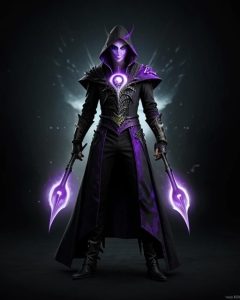Warlocks, shrouded in mystery and often feared for their mastery of the occult, have long captured the fascination of people across cultures and throughout time. In this article, we embark on a journey to unravel the complexities of the warlock, delving into their origins, depictions in myth and folklore, historical contexts, and modern interpretations. Through a multidisciplinary approach, we aim to shed light on the enduring allure of warlocks, exploring the blurred boundaries between myth and reality and the cultural significance of these enigmatic figures.
The term “warlock” is rooted in Old English and Old Norse words meaning “oathbreaker” or “deceiver.” In medieval Europe, warlocks were often portrayed as male witches who had broken their vows to serve a higher power. However, the concept of male practitioners of magic can be traced back to ancient legends and mythologies from various cultures.
Throughout history, warlocks have appeared in mythologies and folklores as powerful sorcerers, dark magicians, or agents of supernatural forces. In Norse mythology, figures like Loki and Grendel exhibit traits associated with warlocks, wielding magic for both good and evil purposes. Similarly, Celtic and Arthurian tales feature characters like Merlin, who blur the lines between wizardry and warlockry.
During the Middle Ages, the fear of witchcraft and sorcery led to the widespread persecution of individuals, primarily women, accused of practicing magic. While male witches were less commonly targeted, the concept of the warlock as a male wielder of dark magic persisted in the collective imagination. Historical accounts of alleged warlocks often reflect societal fears and anxieties surrounding power, gender roles, and religious beliefs.
In modern times, warlocks continue to inspire and captivate through literature, film, television, and gaming. From iconic literary figures like Faust to pop culture icons such as Harry Potter’s Severus Snape, modern depictions of warlocks reflect changing attitudes towards magic, morality, and the supernatural.
Despite their prevalence in myth and fiction, the existence of warlocks as practitioners of dark magic remains a topic of debate and skepticism. While some individuals may identify as warlocks within modern pagan or occult circles, the extent of their supernatural abilities and practices is subjective and often speculative.
In conclusion, warlocks represent a mesmerizing blend of myth, history, and imagination. Whether seen as mythical archetypes, relics of the past, or symbols of the present, the concept of the warlock continues to intrigue and captivate audiences worldwide. By exploring the rich tapestry of legends, beliefs, and representations surrounding warlocks, we gain insight into the human psyche and the enduring allure of the enigmatic and magical.

